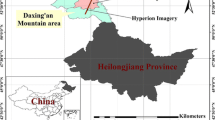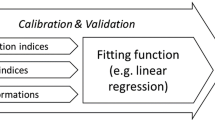Abstract
Spectral index methodology has been widely used in Leaf Area Index (LAI) retrieval at different spatial scales. There are differences in the spectral response of different remote sensors and thus spectral scale effect generated during the use of spectral indices to retrieve LAI. In this study, PROSPECT, leaf optical properties model and Scattering by Arbitrarily Inclined Layers (SAIL) model, were used to simulate canopy spectral reflectance with a bandwidth of 5 nm and a Gaussian spectral response function was employed to simulate the spectral data at six bandwidths ranging from 10 to 35 nm. Additionally, for bandwidths from 5 to 35 nm, the correlation between the spectral index and LAI, and the sensitivities of the spectral index to changes in LAI and bandwidth were analyzed. Finally, the reflectance data at six bandwidths ranging from 40 to 65 nm were used to verify the spectral scale effect generated during the use of the spectral index to retrieve LAI. Results indicate that Vegetation Index of the Universal Pattern Decomposition (VIUPD) had the highest accuracy during LAI retrieval. Followed by Normalized Difference Vegetation Index (NDVI), Modified Simple Ratio Indices (MSRI) and Triangle Vegetation Index (TVI), although the coefficient of determination R 2 was higher than 0.96, the retrieved LAI values were less than the actual value and thus lacked validity. Other spectral indices were significantly affected by the spectral scale effect with poor retrieval results. In this study, VIUPD, which exhibited a relatively good correlation and sensitivity to LAI, was less affected by the spectral scale effect and had a relatively good retrieval capability. This conclusion supports a purported feature independent of the sensor of this model and also confirms the great potential of VIUPD for retrieval of physicochemical parameters of vegetation using multi-source remote sensing data.
Similar content being viewed by others
References
Bannari A, Morin D, Bonn F et al., 1995. A review of vegetation indices. Remote Sensing Reviews, 13(1): 95–120. doi: 10.1080/02757259509532298
Bicheron P, Leroy M, 1999. A method of biophysical parameter retrieval at global scale by inversion of a vegetation reflectance model. Remote Sensing of Environment, 67(3): 251–266. doi: 10.1016/S0034-4257(98)00083-2
Broge N H, Leblanc E, 2001. Comparing prediction power and stability of broadband and hyperspectral vegetation indices for estimation of green leaf area index and canopy chlorophyll density. Geochimica Et Cosmochimica Acta, 76(2): 156–172. doi: 10.1016/S0034-4257(00)00197-8
Cho M A, Skidmore A K, 2006. A new technique for extracting the red edge position from hyperspectral data: the linear extrapolation method. Remote Sensing of Environment, 101(2): 181–193. doi: 10.1016/j.rse.2005.12.011
Danson F M, Plummer S E, 1995. Red-edge response to forest leaf area index. International Journal of Remote Sensing, 16(1): 183–188. doi: 10.1080/01431169508954387
Darvishzadeh R, Skidmore A, Schlerf M et al., 2008a. Inversion of a radiative transfer model for estimating vegetation LAI and chlorophyll in a heterogeneous grassland. Remote Sensing of Environment, 112(5): 2592–2604. doi: 10.1016/j.rse.2007.12.003
Darvishzadeh R, Skidmore A, Schlerf M et al., 2008b. LAI and chlorophyll estimation for a heterogeneous grassland using hyperspectral measurements. Isprs Journal of Photogrammetry & Remote Sensing, 63(4): 409–426. Doi: 10.1016/j. isprsjprs.2008.01.001
Daughtry C S T, Walthall C L, Kim M S et al., 2000. Estimating corn leaf chlorophyll concentration from leaf and canopy reflectance. Remote Sensing of Environment, 74(2): 229–239. doi: 10.1016/S0034-4257(00)00113-9
Delegido J, Verrelst J, Rivera J P et al., 2015. Brown and green, lai mapping through spectral indices. International Journal of Applied Earth Observation & Geoinformation, 35(Part B): 350–358. doi: 10.1016/j.jag.2014.10.001
Elvidge C D, Chen Z, 1995. Comparison of broad-band and narrow-band red and near-infrared vegetation indices. Remote Sensing of Environment, 54(1): 38–48. doi: 10.1016/0034-4257(95)00132-K
Everitt J H, Yang C, 2007. Mapping broom snakeweed through image analysis of color-infrared photography and digital imagery. Environmental Monitoring & Assessment, 134(1–3): 287–92. doi: 10.1007/s10661-007-9619-0
Feret J B, François C, Asner G P et al., 2008. Prospect-4 and 5: advances in the leaf optical properties model separating photosynthetic pigments. Remote Sensing of Environment, 112(6): 3030–3043. doi: 10.1016/j.rse.2008.02.012
Filella I, 1994. The red edge position and shape as indicators of plant chlorophyll content, biomass and hydric status. International Journal of Remote Sensing, 15(7): 1459–1470. doi: 10.1080/01431169408954177
Goel N S, Thompson R L, 1984. Inversion of vegetation canopy reflectance models for estimating agronomic variables. v. estimation of leaf area index and average leaf angle using measured canopy reflectances. Remote Sensing of Environment, 16(1): 69–85. doi: 10.1016/0034-4257(84) 90028-2
Haboudane D, Miller J R, Pattey E et al., 2004. Hyperspectral vegetation indices and novel algorithms for predicting green lai of crop canopies: modeling and validation in the context of precision agriculture. Remote Sensing of Environment, 90(3): 337–352. doi: 10.1016/j.rse.2003.12.013
Haboudane D, Miller J R, Tremblay N et al., 2002. Integrated narrow-band vegetation indices for prediction of crop chlorophyll content for application to precision agriculture. Remote Sensing of Environment, 81(2–3): 416–426. doi: 10.1016/S0034-4257(02)00018-4
Houborg R, Soegaard H, Boegh E, 2007. Combining vegetation index and model inversion methods for the extraction of key vegetation biophysical parameters using terra and aqua modis reflectance data. Remote Sensing of Environment, 106(1): 39–58. doi: 10.1016/j.rse.2006.07.016
Jacquemoud S, Baret F, 1990. PROSPECT: a model of leaf optical properties spectra. Remote sensing of Environment, 34(2): 75–91. doi: 10.1016/0034-4257(90)90100-Z
Jacquemoud S, Baret F, Andrieu B et al., 1995. Extraction of vegetation biophysical parameters by inversion of the prospect + sail models on sugar beet canopy reflectance data: application to tm and aviris sensors. Remote Sensing of Environment, 52(3): 163–172. doi: 10.1016/0034-4257(95)00018-V
Kim H O, Yeom J M, 2014. Effect of red-edge and texture features for object-based paddy rice crop classification using rapideye multi-spectral satellite image data. International Journal of Remote Sensing, 35(19): 7046–7068. doi: 10.1080/01431161.2014.965285
Li F, Miao Y X, Feng G H et al., 2014. Improving estimation of summer maize nitrogen status with red edge-based spectral vegetation indices. Field Crops Research, 157(2): 111–123. doi: 10.1016/j.fcr.2013.12.018
Lin Sen, Liu Ronggao, 2016. A simple method to extract tropical monsoon forests using NDVI based on MODIS data: a case study in South Asia and Peninsula Southeast Asia. Chinese Geographical Science, 26(1): 22–34. doi: 10.1007/s11769-015-0789-3
Marceau D J, Hay G J, 1999. Remote sensing contributions to the scale issue. Canadian Journal of Remote Sensing Journal Canadien De Télédétection, 25(4): 357–366. doi: 10.1080/07038992.1999.10874735
Moody A, Woodcock C E, 1995. The influence of scale and the spatial characteristics of landscapes on land-cover mapping using remote sensing. Landscape Ecology, 10(6): 363–379. doi: 10.1007/BF00130213
Nguy-Robertson A L, 2013. The mathematical identity of two vegetation indices: mcari2 and mtvi2. International Journal of Remote Sensing, 34(34): 7504–7507. doi: 10.1080/01431161.2013.823525
Paul J C, Edward J M, 1983. The relationships between the chlorophyll concentration, LAI and reflectance of a simple vegetation canopy. International Journal of Remote Sensing, 4(2): 247–255. doi: 10.1080/01431168308948544
Pisek J, Chen J M, 2007. Comparison and validation of modis and vegetation global LAI products over four bigfoot sites in north America. Remote Sensing of Environment, 109(1): 81–94. doi: 10.1016/j.rse.2006.12.004
Rogers J N, Parrish C E, Ward L G et al., 2015. Evaluation of field-measured vertical obscuration and full waveform lidar to assess salt marsh vegetation biophysical parameters. Remote Sensing of Environment, 156: 264–275. doi: 10.1016/j.rse. 2014.09.035
Stéphane J, Wout V, Frédéric B et al., 2009. Prospect + sail models: a review of use for vegetation characterization. Remote Sensing of Environment, 113(2009): S56–S66. doi: 10.1016/j.rse.2008.01.026
Su Lihong, Li Xiaowen, Huang Yuxia, 2001. A review on scale in remote sensing. Advance in Earth Sciences, 16(4): 544–548. (in Chinese)
Sun Li, Cheng Lijuan, 2010. Analysis of spectral response of vegetation leaf biochemical components. Spectroscopy & Spectral Analysis, 30(11): 3031–3035(5). (in Chinese)
Teillet P M, Staenz K, William D J, 1997. Effects of spectral, spatial, and radiometric characteristics on remote sensing vegetation indices of forested regions. Remote Sensing of Environment, 61(1): 139–149. doi: 10.1016/S0034-4257(96)00248-9
Thenkabail P S, Smith R B, Pauw E D, 2000. Hyperspectral vegetation indices and their relationships with agricultural crop characteristics. Remote Sensing of Environment, 71(2): 158–182. doi: 10.1016/S0034-4257(99)00067-X
Vuolo F, Neugebauer N, Bolognesi S F et al., 2013. Estimation of leaf area index using deimos-1 data: application and transferability of a semi-empirical relationship between two agricultural areas. Remote Sensing, 5(3): 1274–1291. doi: 10.3390/rs 5031274
Weiss M, Baret F, Smith G J, 2004. Review of methods for in situ leaf area index (LAI) determination: part ii. estimation of LAI, errors and sampling. Agricultural & Forest Meteorology, 121(1): 37–53. doi: 10.1016/j.agrformet.2003.08.001
Wu C Y, Han X Z, Niu Z et al., 2010a. An evaluation of eo-1 hyperspectral hyperion data for chlorophyll content and leaf area index estimation. International Journal of Remote Sensing, 31(4): 1079–1086. doi: 10.1080/01431160903252335
Wu C Y, Niu Z, Wang J D et al., 2010b. Predicting leaf area index in wheat using angular vegetation indices derived from in situ canopy measurements. Canadian Journal of Remote Sensing, 36(4): 301–312. doi: 10.5589/m10-050
Wang Jihua, Huang Wenjiang, Zhao Chunjiang et al., 2003. The inversion of leaf biochemical components and grain quality indicators of winter wheat with spectral reflectance. Journal of Remote Sensing, (4): 277–284. (in Chinese)
Wang Q, Samuel A, John T et al., 2005. On the relationship of ndvi with leaf area index in a deciduous forest site. Remote Sensing of Environment, 94(2): 244–255. doi: 10.1016/j.rse.2004.10.006
Wen J G, Liu Q, Liu Q H et al., 2009. Scale effect and scale correction of land-surface albedo in rugged terrain. International Journal of Remote Sensing, 30(20): 5397–5420. doi: 10.1080/01431160903130903
Zhang L F, Furumi S, Muramatsu K et al., 2006. Sensor-independent analysis method for hyperspectral data based on the pattern decomposition method. International Journal of Remote Sensing, 27(21): 4899–4910. doi: 10.1080/014311606 00702640
Zhang L F, Furumi S, Muramatsu K et al., 2007. A new vegetation index based on the universal pattern decomposition method. International Journal of Remote Sensing, 28(1–2): 107–124. doi: 10.1080/01431160600857402
Zhang L F, Liu B, Zhang B et al., 2010. An evaluation of the effect of the spectral response function of satellite sensors on the precision of the universal pattern decomposition method. International Journal of Remote Sensing, 31(8): 2083–2090. doi: 10.1080/01431160903246675
Author information
Authors and Affiliations
Corresponding author
Additional information
Foundation item: Under the auspices of National Natural Science Foundation of China (No.41401002), Jilin Province Science Foundation for Youths (No. 20160520077JH)
Rights and permissions
About this article
Cite this article
Du, H., Jiang, H., Zhang, L. et al. Evaluation of spectral scale effects in estimation of vegetation leaf area index using spectral indices methods. Chin. Geogr. Sci. 26, 731–744 (2016). https://doi.org/10.1007/s11769-016-0833-y
Received:
Accepted:
Published:
Issue Date:
DOI: https://doi.org/10.1007/s11769-016-0833-y




